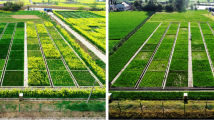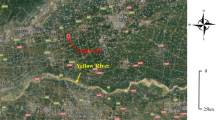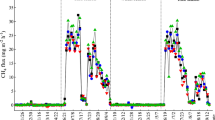Abstract
Purpose
The partial substitution of mineral fertilizers with straw in agricultural soils could help to control soil acidification, reduce the risk of eutrophication from agricultural runoff, and increase the utilization efficiency of straw. However, the effects of such coupled practices on greenhouse gas (GHG) emissions and production yields in vegetable fields are not clear. Therefore, the objectives of this study were to (1) understand methane (CH4) and nitrous oxide (N2O) emissions in response to the same amounts of straw return with varied amounts of mineral fertilizers, and (2) to identify a solution which could better coordinate GHG emissions, vegetable production yield, and the utilization of agricultural straw following disposal.
Materials and methods
We conducted four-season (lettuce-cabbage-chili-lettuce) vegetable cultivation for 1 year using a control treatment (CT), mineral fertilization only (F), and four mineral fertilization treatments plus maize straw (FS, 0.7FS, 0.6FS, and 0.5FS). We then examined seasonal changes of CH4 and N2O fluxes, CH4 and N2O cumulative emissions, soil organic carbon (SOC), nitrate nitrogen (NO3−-N) and ammonium nitrogen (NH4+-N) content, vegetable yields, global warming potential (GWP), greenhouse gas intensity (GHGI), and N2O emission factors (EF).
Results and discussion
Compared to the F treatment, the application of maize straw increased the N2O flux significantly in the FS, 0.7FS, 0.6FS, and 0.5FS treatments. In treatments with added straw, the reduced application of mineral fertilizer led to a reduction in the cumulative N2O emission; this was due to the reduced content of NO3−-N content. The lowest CH4 flux and cumulative CH4 emission were observed in the 0.7FS treatment; this may be due to a form of competitive oxidation between CH4 and NH4+-N from urea. Furthermore, the application of maize straw in combination with a full dose of mineral fertilizers led to high GWP and GHGI values, which showed increases of 88.7% and 78.8%, respectively, in comparison with the F treatment. When taking SOC storage variations into account, which were caused by straw decomposition during cultivation, we identified a negative net GHGI (NGHGI) value (− 0.0448 kg CO2-eq kg−1 yield) in the 0.7FS treatment. This indicated that the NGHGI had decreased by 116.2% relative to the F treatment when based on similar vegetable yields.
Conclusions
Straw combined with 70% mineral fertilizer led to better GHG emissions and vegetable yield when taking into account the carbon sequestration and decomposition caused by the addition of straw.



Similar content being viewed by others
References
Allen DE, Kingston G, Rennenberg H, Dalal RC, Schmidt S (2010) Effect of nitrogen fertilizer management and waterlogging on nitrous oxide emission from subtropical sugarcane soils. Agric Ecosyst Environ 136:209–217
Baggs EM, Stevenson M, Pihlatie M, Regar A, Cook H, Cadisch G (2003) Nitrous oxide emissions following application of residues and fertiliser under zero and conventional tillage. Plant Soil 254:361–370
Bateman EJ, Baggs EM (2005) Contributions of nitrification and denitrification to N2O emissions from soils at different water-filled pore space. Biol Fertil Soils 41:379–388
Cao CC, Qi YC, Dong YS, Peng Q, Liu XC, Sun LJ, Jia JQ, Guo SF, Yan ZQ (2014) Effects of nitrogen deposition on critical fractions of soil organic carbon in terrestrial ecosystems. Acta Prataculturae Ainica 23:323–332 (in Chinese)
Ceschia E, Béziat P, Dejoux JF, Aubinet M, Bernhofer C, Bodson B, Buchmann N, Carrara A, Cellier P, Di Tommasi P, Elbers JA, Eugster W, Gruenwald T, Jacobs CMJ, Jans WWP, Jones M, Kutsch W, Lanigan G, Magliulo E, Marloie O, Moors EJ, Moureaux C, Olioso A, Osborne B, Sanz MJ, Saunders M, Smith P, Soegaard H, Wattenbach M (2010) Management effects on net ecosystem carbon and GHG budgets at European crop sites. Agric Ecosyst Environ 139:363–383
Chan ASK, Steudler PA (2006) Carbon monoxide uptake kinetics in unamended and long-term nitrogen-amended temperate forest soils. FEMS Microbiol Ecol 57:343–354
Chen C, Pan J, Lam SK (2014) A review of precision fertilization research. Environ Earth Sci 71:4073–4080
Chen D, Wang C, Shen J, Li Y, Wu J (2018) Response of CH4 emissions to straw and biochar applications in double-rice cropping systems: insights from observations and modeling. Environ Pollut 235:95–103
Chen H, Zhou J, Li B, Xiong ZQ (2019) Yield-scaled N2O emissions as affected by nitrification inhibitor and overdose fertilization under an intensively managed vegetable field: a three-year field study. Atmos Environ 206:247–257
Cheng Y, Wan J, Wang SQ, Zhang JB, Cai ZC (2014) Effects of soil moisture on gross N transformations and N2O emission in acid subtropical forest soils. Biol Fertil Soils 50:1099–1108
Conrad R (2002) Control of microbial methane production in wetland rice fields. Nutr Cycl Agroecosyst 64:59–69
Dalal RC, Wang W, Robertson GP, Parton W (2003) Nitrous oxide emission from Australian agricultural lands and mitigation options: a review. Aust J Soil Res 41:165–195
Dendooven L, Patino-Zuniga L, Verhulst N, Luna-Guido M, Marsch R, Govaerts B (2012) Global warming potential of agricultural systems with contrasting tillage and residue management in the central highlands of Mexico. Agric Ecosyst Environ 152:50–58
Dossouyovo ER, Brüggemann N, Ampofo E, Igue AM, Jesse N, Huat J, Agbossou EK (2016) Combining no-tillage, rice straw mulch and nitrogen fertilizer application to increase the soil carbon balance of upland rice field in northern Benin. Soil Tillage Res 163:152–159
Gao B, Ju XT, Zhang Q, Christie P, Zhang FS (2011) New estimates of direct N2O emissions from Chinese croplands from 1980 to 2007 using localized emission factors. Biogeosciences 8:3011–3024
Gao B, Ju XT, Su F, Meng Q, Oenema O, Christie P, Chen X, Zhang F (2014) Nitrous oxide and methane emissions from optimized and alternative cereal cropping systems on the North China plain: a two-year field study. Sci Total Environ 472:112–124
Htun YM, Tong YN, Gao PC, Ju XT (2017) Coupled effects of straw and nitrogen management on N2O and CH4 emissions of rain fed agriculture in Northwest China. Atmos Environ 157:156–166
Hu N, Wang B, Gu Z, Tao B, Zhang Z, Hu S, Zhu L, Meng Y (2016) Effects of different straw returning modes on greenhouse gas emissions and crop yields in a rice-wheat rotation system. Agric Ecosyst Environ 223:115–122
Huang Y, Tang YH (2010) An estimate of greenhouse gas (N2O and CO2) mitigation potential under various scenarios of nitrogen use efficiency in Chinese croplands. Glob Chang Biol 16:2958–2970
Huang Y, Zou JW, Zheng XH, Wang YS, Xu XK (2004) Nitrous oxide emissions as influenced by amendment of plant residue with different C: N ratios. Soil Biol Biochem 36:973–981
Huang JX, Chen YQ, Sui P, Gao WS (2013a) Estimation of net greenhouse gas balance using crop- and soil-based approaches: two case studies. Sci Total Environ 456–457:299–306
Huang T, Gao B, Christie P, Ju X (2013b) Net global warming potential and greenhouse gas intensity in a double-cropping cereal rotation as affected by nitrogen and straw management. Biogeosciences 10:7897–7911
Huang R, Lan ML, Liu J, Gao M (2017) Soil aggregate and organic carbon distribution at dry land soil and paddy soil: the role of different straws returning. Environ Sci Pollut Res 24:27942–27952
Huang R, Tian D, Liu J, Lv S, He XH, Gao M (2018) Responses of soil carbon pool and soil aggregates associated organic carbon to straw and straw-derived biochar addition in a dryland cropping mesocosm system. Agric Ecosyst Environ 265:576–586
Huang R, Wang YY, Liu J, Li JC, Xu GX, Luo M, Xu C, Ci E, Gao M (2019) Variation in N2O emission and N2O related microbial functional genes in straw- and biochar-amended and non-amended soils. Appl Soil Ecol 37:57–68
Hütsch BW (2001) Methane oxidation in non-flooded soils as affected by crop production d invited paper. Eur J Agron 14:237–260
IPCC, Climate change (2007) The physical science basis. Cambridge University Press, Cambridge, p 2007
IPCC, Climate change (2014) Mitigation of climate change. Cambridge University Press, Cambridge, p 2014
Jia JX, Sun LY, Kong XW, Yan XY, Xiong ZQ (2012a) Annual N2O and CH4 emissions from intensively managed vegetable fields in Nanjing, China. Soil Sci Plant Nutr 58:91–103
Jia JX, Ma YC, Xiong ZQ (2012b) Net ecosystem carbon budget, net global warming potential and greenhouse gas intensity in intensive vegetable ecosystems in China. Agric Ecosyst Environ 150:27–37
Jiang Y, Van Groenigen KJ, Huang S, Hungate BA, Van Kessel C, Hu S et al (2017) Higher yields and lower methane emissions with new rice cultivars. Glob Chang Biol 23:4728–4738
Ju X, Liu X, Zhang F, Roelcke M (2004) Nitrogen fertilisation, soil nitrate accumulation, and policy recommendations in several agricultural regions of China. AMBIO A J Hum Environ 33:300–305
Kang LY, Fan BQ, Chen S, Chen Q (2018) Fertigation combined with catch crop maximize vegetable yield and minimize N and P surplus. Nutr Cycl Agroecosyst 112:89–99
King GM, Schnell S (1994) Effect of increasing atmospheric methane concentration on ammonium inhibition of soil methane consumption. Nature 370:282–284
Kuzyakov Y, Friedel JK, Stahr K (2000) Review of mechanisms and quantification of priming effects. Soil Biol Biochem 32:1485–1498
Lan ZM, Chen CR, Rashti MR, Yang H, Zhang DK (2017) Stoichiometric ratio of dissolved organic carbon to nitrate regulates nitrous oxide emission from the biochar-amended soils. Sci Total Environ 576:559–571
Li D, Wang X (2007) Nitric oxide emission from a typical vegetable field in the Pearl River Delta, China. Atmos Environ 41:9498–9505
Li B, Fan CH, Zhang H, Chen ZZ, Sun LY, Xiong ZQ (2015) Combined effects of nitrogen fertilization and biochar on the net global warming potential, greenhouse gas intensity and net ecosystem economic budget in intensive vegetable agriculture in southeastern China. Atmos Environ 100:10–19
Liu H, Jiang G, Zhuang H, Wang K (2008) Distribution, utilization structure and potential of biomass resources in rural China: with special references of crop residues. Renew Sust Energ Rev 12:1402–1418
Lu F, Wang X, Han B, Ouyang Z, Duan X, Zheng H (2010) Net mitigation potential of straw return to Chinese cropland: estimation with a full greenhouse gas budget model. Ecol Appl 20:634–647
Luo GJ, Kiese R, Wolf B, Butterbach-Bahl K (2013) Effects of soil temperature and moisture on methane uptake and nitrous oxide emissions across three different ecosystem types. Biogeosci Discuss 10:927–965
Mosier AR, Halvorson AD, Reule CA, Liu XJ (2006) Net global warming potential and greenhouse gas intensity in irrigated cropping systems in northeastern Colorado. J Environ Qual 35:1584–1598
Mu ZJ, Huang AY, Ni JP, Li JQ, Liu YY, Shi S, Xie DT, Hatano R (2013) Soil greenhouse gas fluxes and net global warming potential from intensively cultivated vegetable fields in southwestern China. J Soil Sci Plant Nutr 13:566–578
Nakajima M, Cheng WG, Tang SR, Hori Y, Yaginuma E, Hattori S, Tawaraya K, Xu XK (2016) Modeling aerobic decomposition of rice straw during the off-rice season in an Andisol paddy soil in a cold temperate region of Japan: effects of soil temperature and moisture. Soil Sci Plant Nutr 62:90–98
NBSC (2014) China statistical Yearbook-2014, national bureau of statistics of China. China Statistics Press, Beijing
NBSC (2017) China statistical Yearbook-2017, national bureau of statistics of China. China Statistics Press, Beijing
Robertson GP, Grace PR (2004) Greenhouse gas fluxes in tropical and temperate agriculture: the need for a full-cost accounting of global warming potentials. Environ Dev Sustain 6:51–63
Shan J, Yan X (2013) Effects of crop residue returning on nitrous oxide emissions in agricultural soils. Atmos Environ 71:170–175
Tang S, Cheng W, Hu R, Guigue J, Kimani SM, Tawaraya K, Xu X (2016) Simulating the effects of soil temperature and moisture in the off-rice season on rice straw decomposition and subsequent CH4 production during the growth season in a paddy soil. Biol Fertil Soils 52:739–748
Tariq A, Vu QD, Jensen LS, De Tourdonnet S, Sander BO, Wassmann R, Mai TV, De Neergaard A (2017) Mitigating CH4 and N2O emissions from intensive rice production systems in northern Vietnam: efficiency of drainage patterns in combination with rice residue incorporation. Agric Ecosyst Environ 249:101–111
Vera JC, Valeiro A, Posse G, Acreche MM (2017) To burn or not to burn: the question of straw burning and nitrogen fertilization effect on nitrous oxide emissions in sugarcane. Sci Total Environ 587:399–406
Wang YQ, Guo XS (2008) Decomposition characteristics of crop-stalk under different incorporation methods. Chin J Eco-Agric 16:607–610 (in Chinese)
Wang JY, Xiong ZQ, Yan XY (2011) Fertilizer-induced emission factors and background emissions of N2O from vegetable fields in China. Atmos Environ 45:6923–6929
Xiong ZQ, Zhang XX (2017) Key role of efficient nitrogen application in low carbon agriculture. J Plant Nutr Fertil 23:1433–1440 (in Chinese)
Xiong ZQ, Xie YX, Xing GX, Zhu ZL, Butenhoff C (2006) Measurements of nitrous oxide emissions from vegetable production in China. Atmos Environ 40:2225–2234
Yang JH, Wang CL, Dai HL (2008) Agricultural soil analysis and environmental monitoring. China Land Press, Beijing (in Chinese)
Zhang AF, Bian RJ, Pan GX, Cui LQ, Hussain Q, Li LQ, Zheng JW, Zheng JF, Zhang XH, Han XJ, Yu XY (2012) Effects of biochar amendment on soil quality, crop yield and greenhouse gas emission in a Chinese rice paddy: a field study of 2 consecutive rice growing cycles. Field Crops Res 127:153–160
Zhang WF, Dou ZX, He P, Ju XT, Powlson D, Chadwick D, Norse D, Lu Y, Zhang Y, Wu L, Chen X, Cassman K, Zhang FS (2013) New technologies reduce greenhouse gas emissions from nitrogenous fertilizer in China. Proc Natl Acad Sci 110:8375–8380
Zhang M, Fan CH, Li QL, Li B, Zhu YY, Xiong ZQ (2015a) A 2-yr field assessment of the effects of chemical and biological nitrification inhibitors on nitrous oxide emissions and nitrogen use efficiency in an intensively managed vegetable cropping system. Agric Ecosyst Environ 201:43–50
Zhang ZS, Guo LJ, Liu TQ, Li CF, Cao CG (2015b) Effects of tillage practices and straw returning methods on greenhouse gas emissions and net ecosystem economic budget in rice-wheat cropping systems in Central China. Atmos Environ 122:636–644
Zhang M, Chen ZZ, Li QL, Fan CH, Xiong ZQ (2016a) Quantitative relationship between nitrous oxide emissions and nitrogen application rate for a typical intensive vegetable cropping system in southeastern China. Clean- Soil Air Water 44:1725–1732
Zhang M, Li B, Xiong ZQ (2016b) Effects of organic fertilizer on net global warming potential under an intensively managed vegetable field in southeastern China: a three-year field study. Atmos Environ 145:92–103
Zhang X, Zhang J, Zheng CY, Guan DH, Xie FJ, Chen JF, Hang XN, Jiang Y, Deng AX, Afreh D, Zhang WJ (2017) Significant residual effects of wheat fertilization on greenhouse gas emissions in succeeding soybean growing season. Soil Tillage Res 169:7–15
Zhang FG, Che YY, Xiao Y (2019) Effects of rice straw incorporation and N fertilizer on ryegrass yield, soil quality, and greenhouse gas emissions from paddy soil. J Soils Sediments 19:1053–1063
Zhao YC, Wang MY, Hu SJ, Zhang XD, Ouyang Z, Zhang GL, Huang B, Zhao SW, Wu JS, Xie DT, Zhu B, Yu DS, Pan GX, Xu SX, Shi XZ (2018) Economics- and policy-driven organic carbon input enhancement dominates soil organic carbon accumulation in Chinese croplands. Proc Natl Acad Sci U S A 115:4045–4050
Zheng XH, Han SH, Huang Y, Wang YS, Wang MX (2004) Re-quantifying the emission factors based on field measurements and estimating the direct N2O emission from Chinese croplands. Glob Biogeochem Cycles 18:GB2018
Zhu TB, Zhang JB, Cai ZC (2011) The contribution of nitrogen transformation processes to total N2O emissions from soils used for intensive vegetable cultivation. Plant Soil 343:313–327
Zhu TB, Zhang JB, Yang WY, Cai ZC (2013) Effects of organic material amendment and water content on NO, N2O, and N2 emissions in a nitrate-rich vegetable soil. Biol Fertil Soils 49:153–163
Funding
This work was supported by the National Key Research and Development Plan (Reference: 2017YFD0800101) and the National Natural Science Foundation of China (Reference: 41461069).
Author information
Authors and Affiliations
Corresponding authors
Additional information
Responsible editor: Zucong Cai
Publisher’s note
Springer Nature remains neutral with regard to jurisdictional claims in published maps and institutional affiliations.
Electronic supplementary material
ESM 1
(DOCX 592 kb)
Rights and permissions
About this article
Cite this article
Huang, R., Liu, J., He, X. et al. Reduced mineral fertilization coupled with straw return in field mesocosm vegetable cultivation helps to coordinate greenhouse gas emissions and vegetable production. J Soils Sediments 20, 1834–1845 (2020). https://doi.org/10.1007/s11368-019-02477-2
Received:
Accepted:
Published:
Issue Date:
DOI: https://doi.org/10.1007/s11368-019-02477-2




